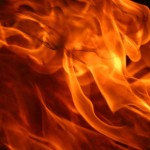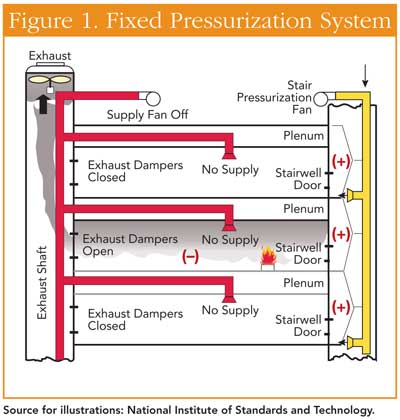Smoke Management in High-Rise Structures
By Christopher J. Naum, SFPE on Feb 16, 2012 with Comments 0
Smoke Management in High-Rise Structures
BY JOSEPH CHACON AND STEVE KERBER
Excerpt from Fire Engineering.com
Most modern building codes define a high-rise structure as a building greater than 75 feet in height from the lowest level of fire department vehicle access to the highest occupiable floor. When fires occur in high-rise structures, the responding firefighters are faced with many challenges. Because of the unique aspects of high-rise buildings, routine fire tactics, including ventilation, can become very difficult. Responding fire personnel must be familiar with fixed smoke management systems as well as options for positive-pressure ventilation (PPV) to ensure the safety and effectiveness of fireground operations.
 The spread of smoke and toxic gas is recognized as a major hazard in all structure fires. In high-rise buildings, smoke can travel to locations remote from the fire through stairwells, elevator shafts, and other vertical openings. As smoke spreads to upper floors and through stairwells, visibility and toxicity become major concerns. Firefighting operations and evacuation can be complicated by smoke-filled stairways. Using both built-in or “fixed” smoke management systems and PPV can increase the survivability of occupants and effectiveness of firefighting operations.
The spread of smoke and toxic gas is recognized as a major hazard in all structure fires. In high-rise buildings, smoke can travel to locations remote from the fire through stairwells, elevator shafts, and other vertical openings. As smoke spreads to upper floors and through stairwells, visibility and toxicity become major concerns. Firefighting operations and evacuation can be complicated by smoke-filled stairways. Using both built-in or “fixed” smoke management systems and PPV can increase the survivability of occupants and effectiveness of firefighting operations.
FIXED SMOKE MANAGEMENT SYSTEMS
Some modern high-rise structures are provided with fixed smoke management systems. These systems are designed to provide a tenable environment for safe egress for building occupants. As stated in the 2009 International Building Code (IBC) Section 909.1, these systems are not intended for assistance in fire suppression and overhaul activities. Although not designed for use in fire suppression and overhaul, fixed smoke control systems can be used in conjunction with other fireground tactics to effectively manage smoke, heat, and other products of combustion.
On the upper floors of a typical high-rise, most smoke management systems use the pressurization method of smoke control. In most cases, the system is designed to provide a negative pressure on the fire floor. This negative pressure is obtained by exhausting the corridor (or major path of egress) on the fire floor. Activation of the smoke-control equipment is provided through a zoned sprinkler system, engineered smoke detection systems, or manual activation at the system’s control panel.
The fixed smoke management systems also include positive pressurization of all stairwells that serve the high-rise portion of the structure. This positive pressure is obtained through mechanical fans that inject outside air into the stairwell. The purpose of maintaining the positive pressure differential in the stairwell is to keep the stairwell clear of smoke and toxic fumes that may migrate into the stairwell during a fire. Smoke can flow only from a higher pressure to a lower pressure. The fire creates its own pressure, and fans create a slightly higher pressure to control or stop the flow of smoke. Most fire alarm devices in the structure, including sprinkler waterflow alarms, smoke detectors, and heat detectors, will activate the stairwell pressurization fans, as well as manual activation at the system’s control panel.
Another type of fixed smoke management system uses what is referred to as the “exhaust method” to manage smoke. This type of system is commonly used in covered malls, atria, or other large spaces. These systems are designed with the intent of maintaining the smoke layer a minimum of six feet above the highest walking surface. This is achieved by using large mechanical fans near the ceiling to exhaust smoke from the space. These systems also use mechanical fans to provide supply or “makeup” air.
For the complete article go to FireEgineering.com HERE All Rights Reservec
Filed Under: Anatomy of Buildings • Fire Protection Engineering • Protective Systems
























